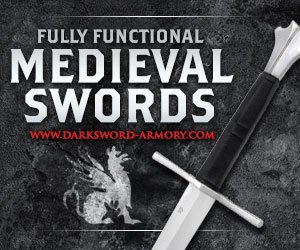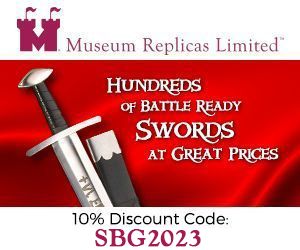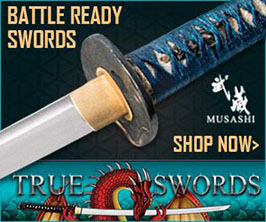- Home
- Renaissance Era Swords
- Cup Hilt Rapier
Taza Cup Hilt Rapier Review
DISCONTINUED
This sword has been discontinued and is no longer in production or available, but is preserved on the site for informational purposes.
The Taza Cup Hilt Rapier by Hanwei is one of their most strikingly attractive swords. But the big question is, what does it REALLY look like in person, and how does it measure up - especially when you consider the new pricing pushes it far outside of the $300 price range most of it's contemporaries sell for?
In this hands on review these questions, and many more, are answered once and for all.
Hanwei Taza Cup Rapier
Review by Charles A. Appel, Marietta USA
|
Steel |
1060 Carbon Steel |
A few weeks ago, I got badly bitten by the rapier bug. After spending a good bit of time looking about the web, I decided to buy the Hanwei Cup Hilt Rapier, a second rapier, and a good many books about rapiers and their use. (It was a really bad bite).
I picked the Cup Hilt (partly) because the cup offers good protection for the hand and I have always liked the big cup guards on epees. In addition the sword was reasonably light weight. And finally, it is a very handsome weapon. (Ok, I'll admit it. I bought it because it looked so nice.)
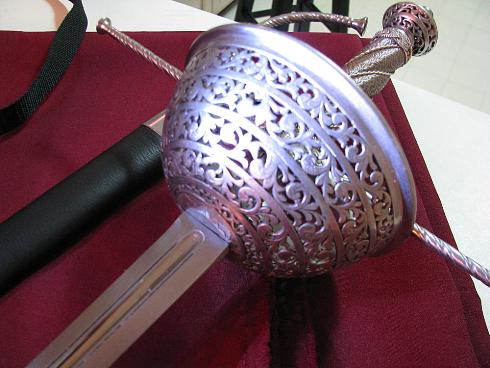
The sword arrived from Kult of Athena, packed in a large corrugated fiberboard box. It was in its scabbard with bubble wrap taped around the hilt. Cushioning was provided by enough plain brown paper to start a fish market
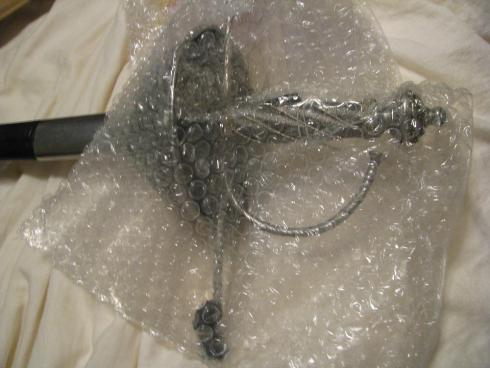
Right away, the Hanwei Rapier impressed me. It is one of the best looking swords I have ever had a chance to examine. The detail work on the hilt is excellent and the handle and pommel are both gorgeous.
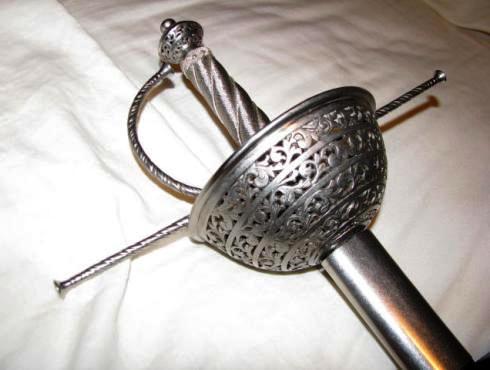
Let's start with a few details about this sword.
Statistics:
- Blade Length: 38.25 Inches
- Handle Length: 3.625 Inches
- Hilt Length: 7.50 Inches
- Blade Length: 38.25 Inches
- Overall Length: 45.75 Inches
- Scabbard Length: 41.50 Inches
- Quillion Length: 11.125 Inches
- Cup Diameter: 5.25 Inches
- Blade Width (at Guard): 1.00 Inches
- Blade Thickness (at Guard): 0.238 Inches
- POB: 4.75 Inches
- COP: 20 Inches
- Sword Weight: 33.35 Ounces
- Scabbard Weight: 8.15 Ounces
- Total Weight: 41.50 Ounces
DESIGN, FIT and FINISH
The Blade
This sword was designed for thrusting (as all rapiers are), but also for light cutting. The first fourteen (14) inches are fairly heavy and blunt. Here, the blade shape is roughly hexagonal. A 13.125 inch fuller begins at about a quarter of an inch from the guard and continues almost to the "transition point" (see below). This fuller is surrounded by an engraved line - filled haphazardly with what may be black enamel. This is the only major cosmetic flaw on the blade, but there are several minor scratches.
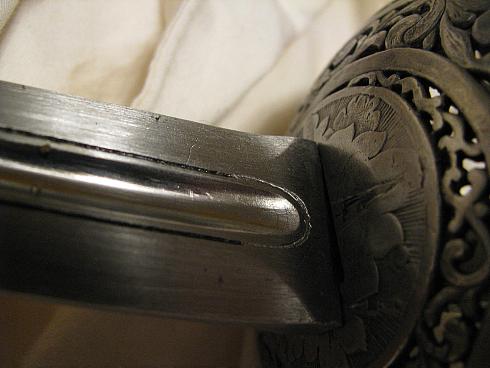
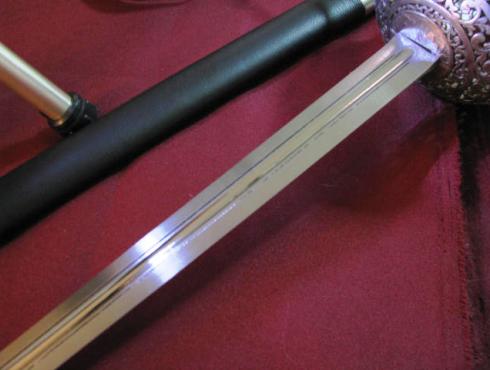
At the fourteen inch mark, we find the transition point. (I'm sure this has a fancy name, but I don't have a clue what it is.) From here to the tip, the blade is diamond shaped and semi-sharp. This gives the user about twenty-four and one quarter inches (24 1/4) of cutting edge.
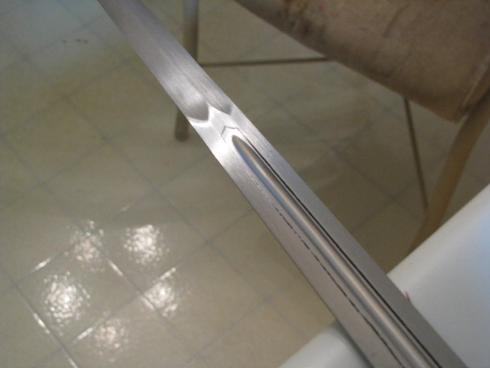
The Grip
The grip (of unknown material) is wrapped with fine wire and a set of twisted secondary wires, which spiral about it. Each end is wrapped with Turk's head knots. I like this grip. It is comfortable to hold - both bare handed and with a glove.
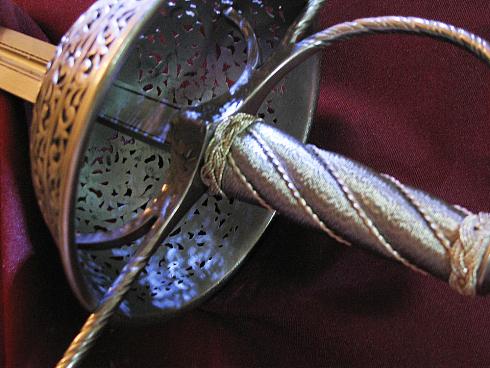
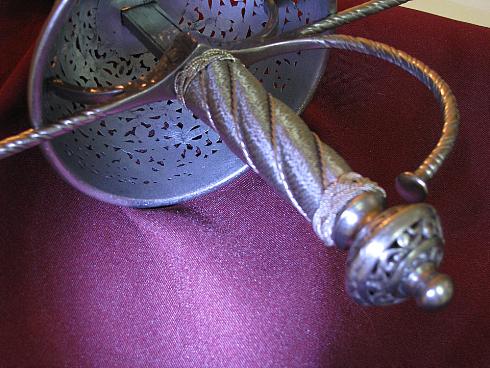
The Pommel
The hollow pommel is a miniature work of art. It is intricately detailed as can be seen in the photos. My guess is that it is cast, but this does not detract from its looks.
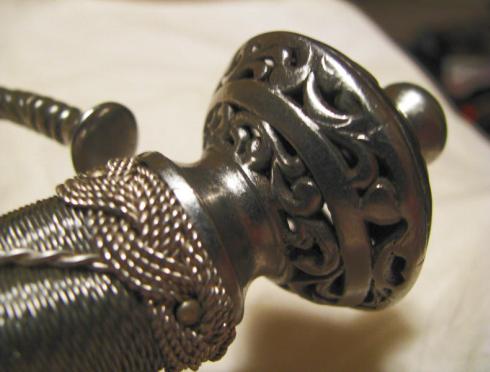
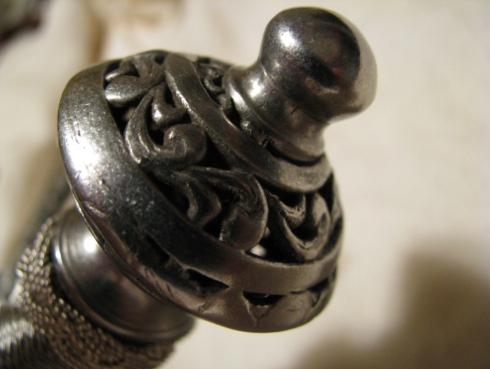
The Guard
The guard consists of a large diameter cup, backed up by long quillions. A series of complex piercings, spiral about the cup from the rim to the center. This not only lightens the sword but is also very appealing to the eye. The quillions are twisted and end in nail head shaped tips. Hanwei states that all of their rapiers use stainless steel hilt components. I tested the guard, grip, and pommel with a strong magnet and these components appear to be non-magnetic. (Some stainless alloys are not magnetic or are only weakly magnetic.)
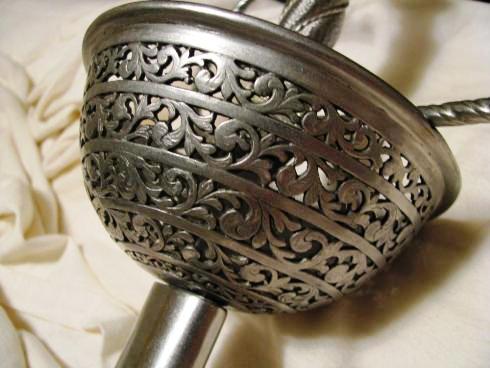
The Scabbard
The scabbard is wood covered with black leather. This is stitched on the back side in a diamond patter. Just beneath the throat, the leather is slightly puffy. The chape and the throat are of a non-magnetic, silvery metal. This could be stainless or it could simply be polished aluminum.
The blade fits the scabbard in a lackadaisical manner. It rattles at the tip end but is fairly snug at the top. Turning the scabbard slightly upside down will drop the sword into your hand (or onto the ground). It is altogether unimpressive, but it is what one would expect in this price range.
TESTING
Thrusting
Thrusting is where this sword shines. This is hardly surprising as rapiers were designed primarily as thrusting weapons. The sword made short work of water filled plastic bottles, and both wet and dry cardboard. Penetration of these targets seemed effortless. I did not try thrusting against plywood or other hard objects. I'm a bit leery thrusting into wood with a blade this thin.
Cutting
As can be seen in the video, as a cutter, this sword is a good thruster. Cutting is not its strong suit - especially in the hands of a novice like me. I was able to cut through one half-gallon milk jug and I made a rather impressive gash in the cutting stand when I totally flubbed a cut. On water filled bottles, I might as well have used a club.
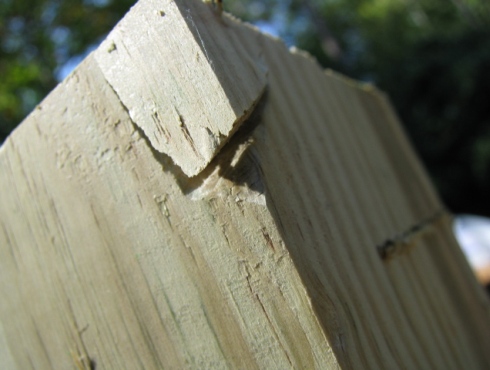
Handling
For me, the sword is very tip heavy. The only thrusting swords I have used before this were foils and epees. (My pistol grip epee weighs in at 13.7 ounces - less than half the weight of this rapier.) The point of balance on my fencing swords is close to the guard. That combined with the light weight makes tip control easy. In essence, the epee and foil act like sports cars where this handles like a full size pickup. But, that is the nature of the beast.
Historical Accuracy
While I was not able to find a sword that matched this one exactly during any of my internet searches, the hilt appears to match the description of a type 100, in A. V. B. Normans "The Rapier and Small-Sword, 1460-1820".
CONCLUSION
Despite the fact that I'm not any good with it yet, I like this sword. In addition, if I put my mind to it, I should be able to work my way up to a satisfactory level of mediocrity. It is simply a matter of getting used to the weight and taking the time to practice.
Pros:
- Extremely attractive
- Comfortable grip
- Excellent thrusting ability
Cons:
- Unsharpened edge and poor cutting ability
- Very plain and uninspired scabbard
- Probably too expensive when compared to other Rapiers by Hanwei
WHERE TO BUY
Like almost all the Renaissance swords we are looking at, this blade has gone the way of the do-do..
However, bearing the good and bad points of this blade in mind, for anyone looking for something similar we strongly suggest you check out the range of Renaissance swords available HERE at Kult of Athena
I hope this review of the Taza Cup Hilt Rapier has been helpful. To return to Renaissance Swords from Taza Cup Hilt Rapier Review, click here










